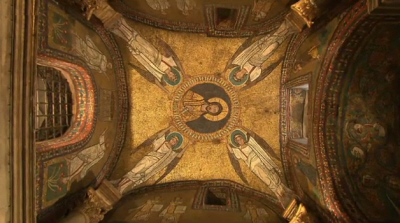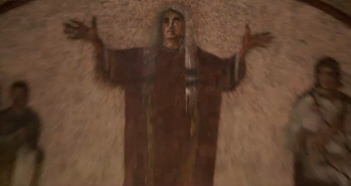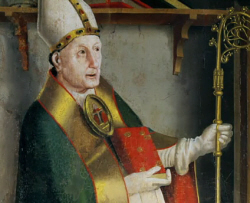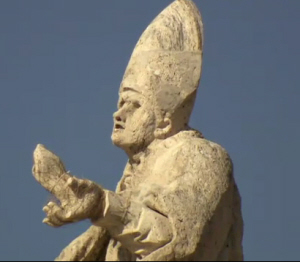Santa Prassede
Theodora, Augustine, Theodo
Evidence of a centuries-old struggle can be found in the church of Santa Prassede. Here there is a tantalising bit of evidence. On this mosaic, you’ve got images of women. There is the Virgin Mary, very obviously, in the middle here and on either side of her there are two others.
But then this woman on the left is really intriguing. She’s been given this strange blue halo, which tells us she was actually alive when the mosaic was made. And the title is written above, Episcopa. Now, Episcopa is the female version of Episcopus, the Latin for a bishop.
That’s her name, though, down the side. She’s obviously a woman, so she’d be called Theodora, but somebody’s tampered with the mosaic. This puts new gold mosaic at the end, so she’s no longer Theodora, but Theodo, so she could almost be a man. It’s almost as if somebody is trying to pretend there were no female bishops here in Rome.

Time and time again, we find that women are not properly represented in Christianity’s history. The story of Thecla isn’t found in the Bible. The evidence from the catacombs of women leading worship is disregarded. And there are no churches or cathedrals dedicated to female priests or bishops. If women were once so crucial, when did it all go wrong?

Christianity may have begun by championing women, but not everyone was happy with this situation. Many eminent theologians were deeply uncomfortable with the women taking such a prominent position.
How did women presume they could play a leading role when their very essence was an affront to God? One Christian, Clement of Alexandria, wrote in the third century AD, “The very consciousness of their own nature must evoke feelings of shame.” And another said that women were not created in God’s image, but instead they destroyed in God’s image.
But there would be one man’s glittering intellect and powers of persuasion that would make this hotchpotch of women-hating bile stick.

Beneath Milan’s Cathedral lie the ruins of a fourth-century baptistery. It’s where people once came to be baptised into the Christian faith. What happened here was perhaps one of the most critical developments in Christian history. Here in 387 AD, a man called Augustine became a Christian. And he’d go on to be one of the most brilliant Christian theologians of all time, but his attitudes would cause trouble for women for the next 1700 years.
We know an awful lot about Augustine’s life, thanks to his detailed autobiography, his Confessions. Augustine tells us that in his younger days, he was obsessed with sex and that, as a teenager, he spent every waking hour hungry with desire. “To love and to be loved was sweet to me, particularly when I enjoyed the body of the one I desired. And so I polluted the spring of friendship with the filth of concupiscence and I dimmed its lustre with the slime of lust.”
But after becoming a Christian, Augustine embraced a life of celibacy. His preoccupation with sex, however, was far from over. He’d go on to develop a theory which would shape how humanity viewed itself. It was a theory so powerful, we’re still living with its consequences today.

Augustine developed the concept of original sin. He believed that the crimes committed by Adam and Eve in the Garden of Eden, when they ate the forbidden fruit, would be perpetuated down the generations, thanks to the act of sex. In other words, when any of us are born, we are already creatures infused with sin to the very core of our being.
Women, in particular, come out of this very badly. Carved into the wall of Milan’s Cathedral is the moment when Augustine believed it all went wrong for humanity. It was Eve who’d encouraged Adam to sin. Eve becomes an archetype for all women, weak and easily fooled. But also the temptress who reads men astray.
Rather than eroticism and sexual desire being considered a gift of the gods as they were in the classical world, now these things are thought of as unremittingly dark and sinful - a betrayal of God himself. Sex was the work of the devil and women were his agents. It fed into the growing notion that women were not the representatives of God. And over the centuries, this belief became so pervasive that eventually history was rewritten.
